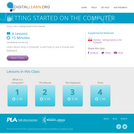
Learn about what a computer is and how to use a mouse and keyboard.
- Subject:
- Education
- Material Type:
- Lecture
- Provider:
- Institute of Museum and Library Services
- Provider Set:
- DigitalLearn.org
- Date Added:
- 07/19/2013


Learn about what a computer is and how to use a mouse and keyboard.
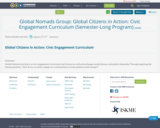
Global Citizens in Action is a civic engagement curriculum that focuses on cultural exchange, media literacy, and global citizenship. Through exploring the driving question, “How do we, as youth, engage our communities to create positive social change?”

How do we, as youth, learn from the conflict in Rwanda to strengthen media access and quality in our own communities? In this program, students will explore the role of the media in Rwanda, before, during, and after the genocide and explore how to expand media access, quality, and equity in their communities and around the world.
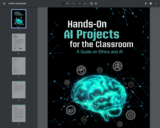
In this guide, students’ exploration of AI is framed within the context of ethical considerations and aligned with standards and concepts, and depths of understanding that would be appropriate across various subject areas and grade levels in K–12. Depending on the level of your students and the amount of time you have available, you might complete an entire project, pick and choose from the listed activities, or you might take students’ learning further by taking advantage of the additional extensions and resources provided for you. For students with no previous experience with AI education, exposure to the guided learning activities alone will create an understanding of their world that they likely did not previously have. And for those with some background in computer science or AI, the complete projects and resources will still challenge their thinking and expose them to new AI technologies and applications across various fields of study.
Project 1: Fair's Fair
Project 2: Who is in Control?
Project 3: The Trade-offs of AI Technology
Project 4: AI and the 21st Century Worker
Visit the ISTE website with all the free practical guides for engaging students in AI creation: https://www.iste.org/areas-of-focus/AI-in-education.

This is a lesson in which students use prior scientific knowledge as well as 21st century skills to create a short video explaining the school's healthy eating policy as well as its scientific underpinnings. It is designed as a method of group assessment at the end of the topic of food science.
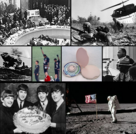
Parte 1 de 4 1960sIn this section, we will cover the Kenny v Johnson presidential election and events that occurred in the first part of the 1960s.En esta seccion vamos a ver la election de Kennedy contra Johnson y othros eventos que ocurrieron durante la primera parte de los 1960s.Parte 1 de 4 1960sApuntes para completar al ver el video / Fill-in -the -Blanks notes to do while watching the videoApuntes / Notes
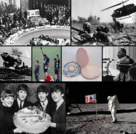
Esta leccion cubre la historia de los Estados Unidos durante la Guerra Fria en los 1960s.This lesson covers the Cold War in the United States in the 1960s.

How to Canva: Tips and Tricks is an online introductory course on Canva. It is designed as open educational resources for educators and all. In this course, you will learn how to customise text, text effects, colours, photos, videos and elements plus pro tips and Ideas for Creative uses of Elements, Keywords and Styles. The videos are concise, purposeful and delivered in easy-to-follow lessons that progressively build one's skills over time. By the end of this course, you will be able to create an attractive Instagram post. Click on View Resource and let's get started!
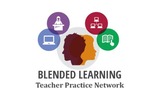
In this problem-based learning unit, the Class will discuss what it means to be empathetic. Then, situations in which empathy is necessary will be role played. Students will then roll 2 dice, one die will determine their audience and the other die will determine the task they are to create a solution to. Sample audience and tasks include creating a tool to access an out of reach object for a child, vision impaired, or person in a wheelchair. Students will hand draw prototypes and then utilize a free online 3D modeling application to design their solutions for sharing.
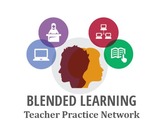
Throughout this problem-based learning module students will address real world skills. Students will be asked to brainstorm ideas and think innovatively both independently and collaboratively in addressing a real-world problem that is relevant to their daily lives and surroundings. Students/teams will be encouraged to use the internet for research purposes in their design phase. What components should be included for a modern, updated classroom? Students will utilize various online platforms to design an ideal, modern, contemporary “dream classroom”. Students will incorporate components that would meet the needs of all learners and a classroom that would be able to integrate technology. These classrooms can be shared with relevant individuals in the community and others in the school building.

Throughout this problem-based learning module students will address real world skills. Students will be asked to brainstorm ideas and think innovatively both independently and collaboratively in addressing a real-world problem that is relevant to their daily lives and surroundings. Students/teams will be encouraged to use the internet for research purposes in their design phase. What components should be included for a modern, updated classroom? Students will utilize various online platforms to design an ideal, modern, 21st century “dream classroom”. Students will incorporate components that would meet the needs of all learners and a classroom that would be able to integrate technology. These classrooms can be shared with relevant individuals in the community and others in the school building.

In this problem-based learning module, students will be given the chance to plan their idea of the perfect party. They are given a budget of $2,500, this is the maximum amount of money they can use. The goal is for students to plan a party that they think people would want to attend and would enjoy being a part of. The students will need to come up with categories of what their party will need (food/drink, decorations, entertainment, location, etc). These will then be the stations students will move at their own pace through to complete the party planning. At each station they will need to identify what they are doing to have/do for the party and how much it will cost. They will then have to figure out the unit cost (cost per person) for that category. The final station should allow for students to find the total cost of their part and total unit cost per person for the party. If the total cost exceeds $2,500 students should make adjustments as needed.Students will then create an advertisement (commercial, flyer, poster etc.) to promote their party as the “PARTY OF THE YEAR!”Students will then present these advertisements to school staff, parents, administrators etc. to vote on the party they would want to throw for their own child. They should take into consideration cost per person, entertainment, and enjoyment of the party.
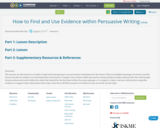
The learner for this lesson is an adult in high school preparing to use persuasive techniques for the future. This is an English language arts lesson and the lesson introduces evidence as something that is necessary to support your claims within persuasive writing. Evidence helps demonstrate the relationship between ideas and words within the claim that should be the key ideas within the essay, passage, or to support a claim. Learners will practice using this evidence to support their claim about their topic, then they will find one piece of evidence from an article on that topic.
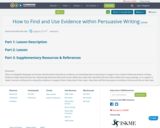
This is an English language arts lesson and the lesson introduces evidence as something that is necessary to support your claims within persuasive writing. Evidence helps demonstrate the relationship between ideas and words within the claim that should be the key ideas within the essay, passage, or to support a claim. Learners will practice using this evidence to support their claim about their topic, then they will find one piece of evidence from an article on that topic.

This textbook is an introduction to journalism, in the African and South African context, written for digital natives. The textbook is unique in the sense that students and the lecturer wrote it together, it is therefore a resource that focuses on learning through the eyes of students in Africa and the things they would like to learn to become journalists. The writers are Andre Gouws, lecturer in journalism at North-West University in Potchefstroom, South Africa, and his first-year and second-year students from 2021.
The purpose of this open textbook is to provide a general introduction to journalism in the 21st century to both journalism students and anyone who, perhaps unknowingly, create their own types of journalism. These new types of journalists include bloggers, entrepreneurial journalists, social media users, newsletter writers, and YouTube and TikTok creators, among others. In the digital era, journalism skills are valuable skills to anyone who creates or distributes news or information. Journalism skills include an understanding of news, the context of the media, legal and ethical issues around creating and distributing all types of content, and practical skills. This textbook contains ideas to help prospective independent journalists with journalistic entrepreneurship. Scholars agree that journalism can be defined very broadly today. It is no longer something that only trained journalists do. Knowing and understanding journalism will help everyone to tell better stories; to perhaps earn an independent income; and, importantly, to do it an ethical and compassionate way.

This unit of study investigates how ICT can support the curriculum and the delivery of skills necessary to function in the 21st century.
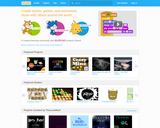
Helps young people learn to think creatively, reason systematically, and work collaboratively — essential skills for life in the 21st century.
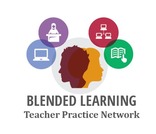
Every school system is unique, but we are all connected by a shared aspiration: that all students have an educational experience that prepares them for success in college, in careers, and in life. Now more than ever, educators must not only provide rigorous academic content, but we must also be more intentional about fostering critical thinking, communication, collaboration, creativity, and other 21st century skills that our young people need to navigate this complex, rapidly changing world. Download this common cartridge file for professional learning on 21st Century Skills
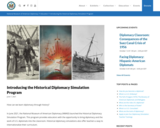
How can we learn diplomacy through history?
In June 2021, the National Museum of American Diplomacy (NMAD) launched the Historical Diplomacy Simulation Program. This program provides educators with the opportunity to bring diplomacy and the work of U.S. diplomats into the classroom. Historical diplomacy simulations also offer teachers a way to internationalize their curriculum.
In most classrooms, discussions about the work of U.S. diplomats and how the U.S. government engages in global issues are absent from the curriculum. To fill this gap, NMAD has developed educational programming to help students better understand diplomacy. These resources show students that many of the opportunities and challenges before the United States are global in source, scope, and solution.
Our signature educational resources are our diplomacy simulations. NMAD’s diplomacy simulations teach students about the work of the U.S. Department of State and the skills and practice of diplomacy as both a concept and a practical set of 21st-century skills. Stepping into the role of diplomats and working in teams, students build rapport with others, present clear arguments, negotiate, find common ground, and compromise to find a potential solution to a real-life historical crisis.
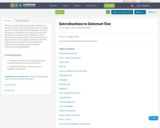
This lesson helps students refine their computer and internet use skills. They will be taught how to do simple searches on the internet to find information, then they will search for information on a topic they care about and present a summary of their findings in order to check for some understanding. This is an introductory lesson into the use of computer and internet use. The skills learned in this lesson will be beneficial for students to start working on furthering their researching and typing abilities.